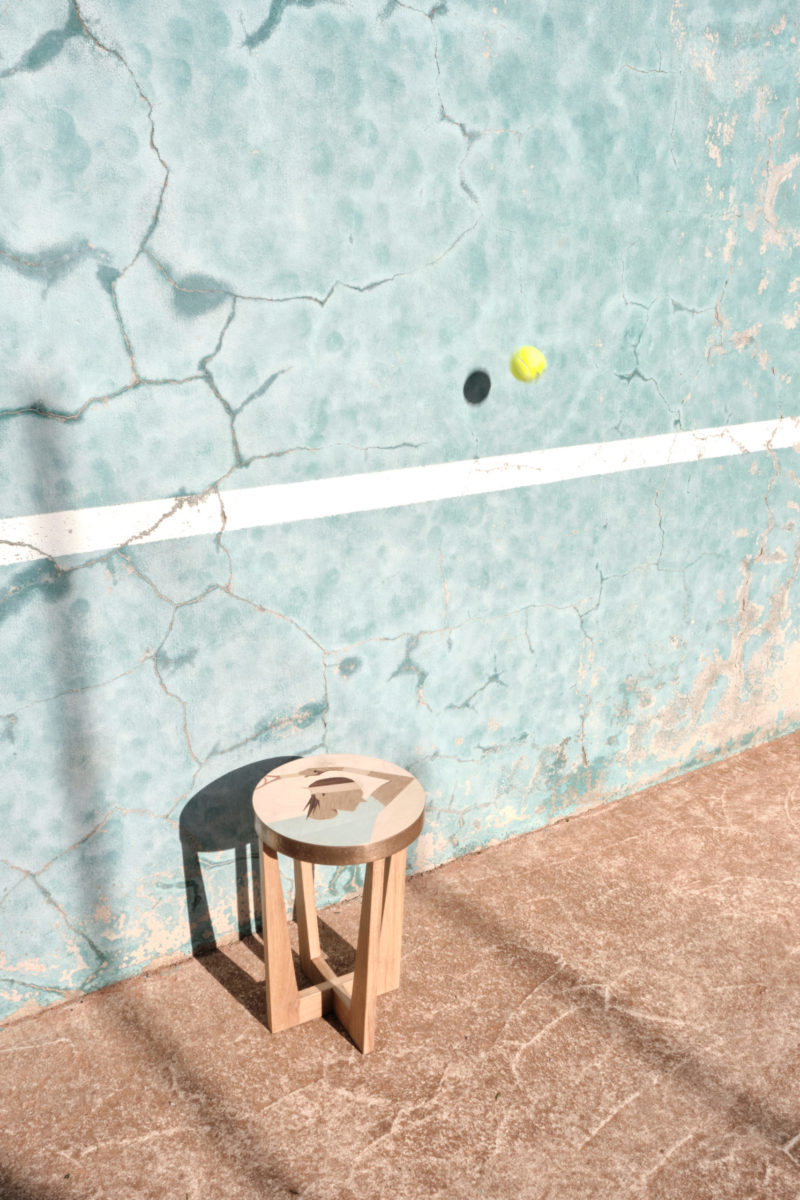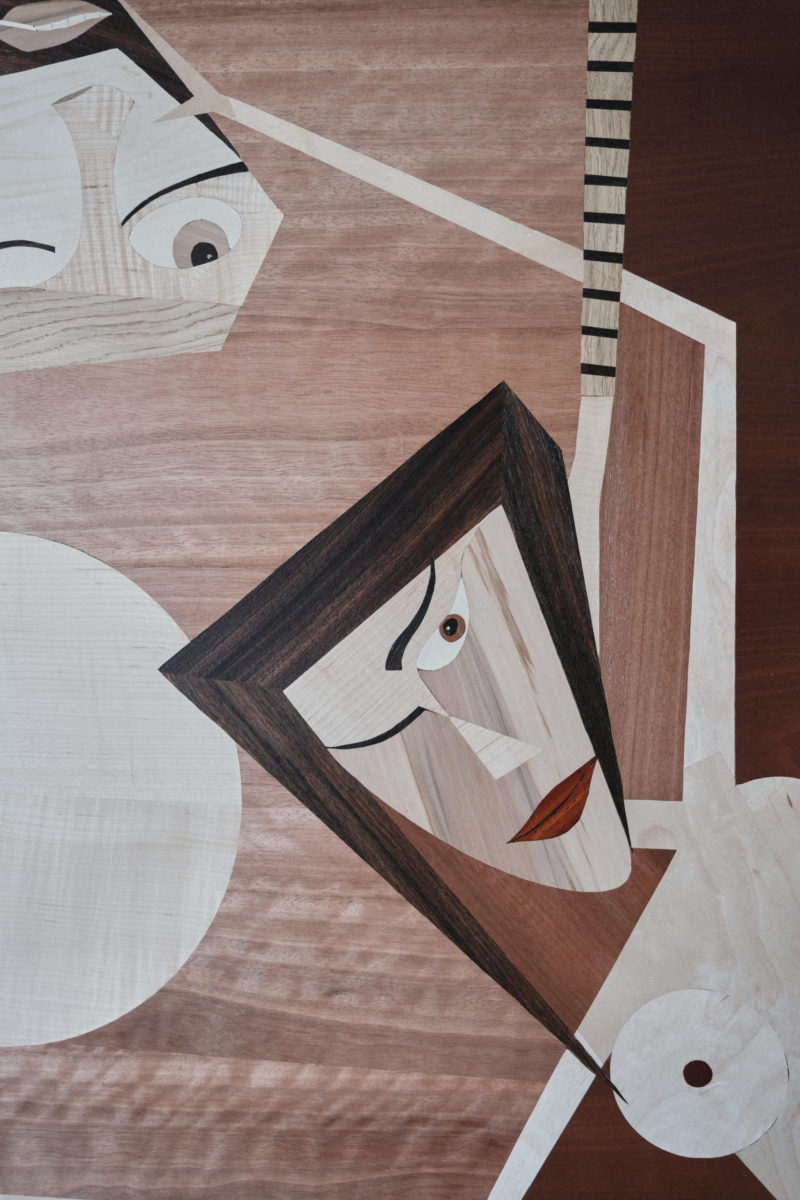Between Monaco and Manacor
By Chris Oddo

French artist Brett Gradel owes his passion for tennis—and art—to his family and his native Côte d’Azur, but when it comes to marquetry he is carving a brave new path that takes him back to the sport he learned from his father.
Imagine a place where art touches tennis and tennis touches art. The result, a dance through shadows and light, a blissful moment in time when the athlete and his artistry coalesce to create one stunning visual. The confluence of those overlapping, limitless circles, is where the artist Brett Gradel spends his time creating divine pieces of art, many of them tennis-themed.
Moon Ball was his first. The stunning homage to the tennis of yesteryear is a stool-“tabouret” in French—but it looks and feels like something more. It is an homage to a time when the giants of tennis were like rock gods; an era when icons like Borg, McEnroe, and Noah were fire, ice, and ecstasy for legions of fans who connected with the sport. Gradel recently handed it off to Marin Čilić at Monte-Carlo, where he volunteers as a driver each year, shuttling the players to and from the pristine club. “I wanted to draw an image a bit classic, like old-style tennis, like vintage, but with a little bit of modern touch,” Gradel tells Courts of his first foray into a marriage of tennis and art, which depicts Čilić on clay, preparing to serve. “Somebody wanted to buy it, somebody sent me a message on Instagram, but I refused. I really wanted to give him the stool in person.”
On his website, www.brettg-design.com, users can see this one-of-a-kind “tabouret” photographed on the vibrant terre battue that is prevalent near Gradel’s hometown of Roquebrune Cap-Martin, just a 10-minute drive from the fabled Monte-Carlo Country Club, home of one of the most breathtaking venues in tennis. They can also see his latest work—a tribute to the King of Clay Rafael Nadal, described on Gradel’s Instagram page as follows: “Made especially for Rafael Nadal, whom I admire for his tennis prowess and his immense humility. The beauty of tennis is timeless. It is for me a warm game. The exchanges and ball percussions make the shadows dance on the warm colors of the courts.”
It is called “Manacor:” Look closely at the piece and find a veritable cornucopia of woods, all seamlessly assimilated. Marquetry, the ancient art form, is work that utilises various types of wood as well as other materials, such as the bronze Gradel used to outline the circumference of this sleek stool. “My idea was to zoom in on Rafa, like a photographer would,” Gradel tells courts. “Nadal is so charismatic that I wanted something really close to him, and something a bit cubist in style.” The tabouret is composed of precious woods—no painting whatsoever: Sycamore burl for the sky behind Nadal, oak for Nadal’s skin, speckled maple (tinted) for Rafa’s baby blue T-shirt, Sycamore (tinted) for Nadal’s vintage headband, teak for the shadows around his bicep and wrist, pear and maple for his racquet. The legs, true to the real-life legend’s form, are made of solid oak. “Despite the power and strength of Rafael Nadal’s game, I wanted this portrait to be soft and luminous in the image of his personality and of this sport,” Gradel says.
The luminosity that Gradel speaks of is the sophistication that makes this piece of art a revelation. He has captured the endless summer, discovered a way to make the King of Clay ageless. Here is Rafa, winning Roland-Garros perpetually, the sun baking the clay, the lines of his face in sync with the lines of nature. “I blend precious wood together,” Gradel explains when I ask him about the piece. He chose to combine the sycamore of the sky with tinted speckled maple of Nadal’s shirt in order to heighten the effect of the Spaniard’s aura. “I love pastels. And also Nadal likes to wear different colors. I also chose something very bright, with a lot of light.” A close-up photo allows the viewer to see the detailed work that Gradel has produced.

The best tennis players need ample time to hone their craft, and the same is true of Gradel and his art. He spent 10 days just to make the drawing for the piece, then almost another month to complete the stool. Gradel first fell in love with art in his youth, thanks to his family. His grandfather was a painter and a craftsman, his grandmother was a dressmaker. Gradel enjoyed tagging along and watching his grandfather work with his hands. “I think I spent almost as much time with them as my parents, I really grew up with them, I was always behind my grandfather, watching what he was doing. He was really good at anything manual, for me he was like a model, since always.” Inspired, and influenced, by the creativity of his progenitors, Gradel’s artistic origins begin with sketches and paintings that he created as a child. Eventually he found himself on his own path, gravitating to woodwork.
“When I was a kid I used to draw a lot and paint as well, and then in time I entered into woodworking,” he says. “I started by myself six years ago, doing a lot of experience with wood and different materials, like leather and some metals and resin and many different things, and I gained a lot of experience. And with all of this experience, I am now into marquetry.” Gradel’s love for tennis is owed to his father. He told Courts that his father plays almost every day, and is in attendance every April, when the ATP Tour comes to Monte-Carlo for the first Masters 1000 event of the clay-court season. His father’s passion for the beautiful game has rubbed off on him. “I really like the atmosphere in tennis,” he says, explaining how he connects with the sport on a visceral level. “For me it is something like vintage or retro, maybe because I started playing tennis when I was a kid, so sometimes I have flashbacks of scenes and the aesthetics of all that you can find in tennis, the color of the clay, I love it. The smell that you can have there. The clothes, the fashion, and the spirit of the sport also.”
Gradel’s art is inspired by his life, and his life has been rich. “I can’t complain,” he tells Courts, modestly. He doesn’t need to. He has lived in Russia and Spain; he is a linguist who speaks five languages, and he’s also a musician and a sportsman. Also an avid surfer, Gradel has spent time surfing in Australia, New Zealand, Indonesia, Tahiti and Mexico, but he always ends up back in the irresistible French Riviera, and who could blame him? “It’s difficult to find another place where I feel home like this,” he says. “We are between the sea and the mountains and next to Italy, so I live about ten minutes’ drive from Italy. In one day I can go to Monaco, eat a pizza in Italy by night and come back for the evening in France, it’s pretty fun. You can do a lot of things without driving too much. Some days I surf in the morning and ski in the afternoon, or the opposite, just driving one hour and a half.”
At Monte-Carlo, Gradel has driven the greats of the game to and from their hotels, out for dinners, and nights on the town, and he has many stories to tell, like how he used Rafael Nadal’s physiotherapist when he injured his knee while living in Mallorca. “I really love Nadal, we had funny talks because he lives and was born in Mallorca and I lived there for two years, so we talk about Mallorca,” he said, adding: “A funny story is that I had a knee problem there and I went to his physiotherapist, and I kept the card of the physiotherapist, who was also the physiotherapist of Nadal. I showed Rafa the card and he couldn’t believe it, that a guy in Monaco showed him the card of his personal physio. It was pretty funny for him.” Now the episode comes full circle. Gradel hopes to have the King of Clay’s signature placed on the stool before it goes to auction, the proceeds ideally going to Nadal’s foundation. There is no other piece like it in the world, now it is up to Nadal to put the finishing touches on another impressive, highly stylised piece of work.
Story published in Courts no. 3, Summer 2022.
